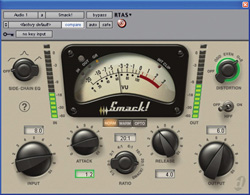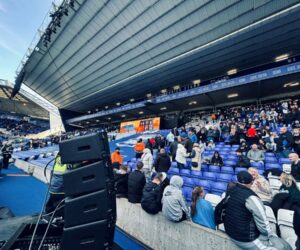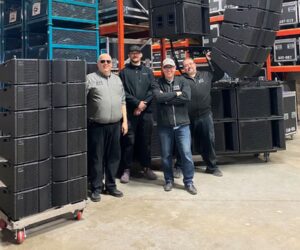There are several types of audio software plug-ins (or “plugs”), third-party software developed to enhance the functionality of software-based digital audio workstations (DAW).
Most plug-ins use host-based or “native” processing. These include Steinberg’s VST (which runs on many platforms), Digidesign’s own RTAS (Pro Tools LE) and Apples’ AU (Logic). We’re interested in TDM (Time Domain Multiplex), a format used by Pro Tools HD that employs DSP cards, reduces latency and is used by Digidesign Venue live sound consoles.
Venue input channels have a built-in compressor, gate and 4-band EQ. The six knobs in the dynamics section provide a unified, consistent set of controls for both built-in and plug-in dynamics processing. To their left, a trio of select and engage switches (each with a 6-LED gain reduction meter) provides access to either the on-board gate, on-board compressor or plug-in software.
Similarly, the controls for Venue’s on-board 4-band input EQ can be toggled to control parametric EQ plug-ins. Other plug-ins are operated from a row of eight rotary encoders. Up to four plug-ins can be inserted into each channel or bus, allowing the comparison or combination of various plug-ins.
In addition to a variety of free “house” DigiRack TDM plug-ins, Digidesign’s VenuePack 3.1 comes with the purchase of Venue consoles and includes their Smack! compressor and Impact mix-bus limiter, plus their Reverb One and ReVibe room-modeling reverb.
Also included are Bomb Factory’s Classic Compressors, MoogerFooger bundle, Pultec bundle and Slightly Rude Compressor, plus Focusrite’s d2 parametric EQ and d3 compressor.
Installing Plug-ins
The Plug-in tab of the Options page is where plug-ins are installed or disabled. A few plug-ins don’t have a fully compatible D-Show installer and must be manually installed, by running a copy of the installer software from the “User Data” partition with the D-Show software turned off.
As with most third-party software, disabling unused plug-ins increases the console’s power-up time.
Most plug-ins are authorized with an iLok USB “smart key” which holds authorizations for a particular account, which must be inserted in the console to authorize them. iLok accounts are free (www.ilok.com), and iLoks themselves are included free with purchases of Digi 002, 003 and Mbox 2.
The Venue has four plug-in “racks” which can each hold up to 25 plug-ins. Multiple copies of a plug-in can be operated, limited only by the console’s DSP. Reverbs have a larger DSP “footprint,” while dynamics and EQ plug-ins require less DSP.
Built-in dynamics and EQ aren’t limited by console DSP, but plug-ins are. DSP can be added by installing an extra Mix Engine card. DSP for plug-ins can be increased slightly by reconfiguring the system for fewer inputs, FX returns, or graphic EQs.
The single-rack MixRack system includes two Mix Engine cards with an option for a third. Each Mix Engine has nine DSP chips. When configured as a 48-channel desk with eight returns, the entire first Mix Engine and one of the nine DSP slots in the second card are used, leaving eight more DSP chips for running plug-ins.
Adding on-board graphic EQs uses another DSP chip for every eight graphs, so configuring a MixRack for 48 inputs, 8 FX returns and 8 graphics leaves seven DSP chips open on a two-Engine MixRack.
Eight instances of ReVibe, which each use half a DSP would use four of the remaining seven in a dual Mix Engine machine, leaving three additional DSP chips for other plug-ins.
If you want to use lots of plug-ins, adding a Mix Engine to a Venue’s base configuration is a must. In the dual-rack system, the FOH Rack’s base configuration is three Mix Engines, and two more can be added for a total of five.
Latency
Venue has delay-compensation guarantees that latency from plug-ins or outboard hardware inserts doesn’t interfere with synchronization of all channels and mix buses. Plug-in latency is less than that of outboard analog inserts, and ranges from a few samples to dozens of samples.
At 48K, the console’s sample rate is 0.02 milliseconds. In addition to the latency of each plug-in, there are 3 samples of DSP chip delay, plus 2 samples for each instance.
A plug-in with 5 samples of latency will add 3 + 5 + 2, or 10 samples for 0.2 milliseconds of added delay. A channel with two plug-ins, one with 25 samples and another with 16 samples, will add 3 + (25 + 2) + (16 + 2), or 48 samples and add 1.0 millisecond of delay.
With no plug-ins, the console has less than 2.8 ms of latency. Low-latency plug-ins won’t affect latency critical applications, such as in-ear monitoring.
Check out our Showcase Photo Gallery Tour of plug-ins that emulate hardware and which the average live sound engineer will find familiar.
Mark Frink is Associate Editor for Live Sound International.
Recent articles by Mark Frink featured on PSW:
Monitor Wedge Tips: Tools Of The Trade To Have A Successful Show
Real World Gear Looks At Medium Format Line Arrays
A Review Of Floor Monitors Of Every Type & Size
Digital Consoles For Clubs: Eight Very Good Reasons To Make The Change




















